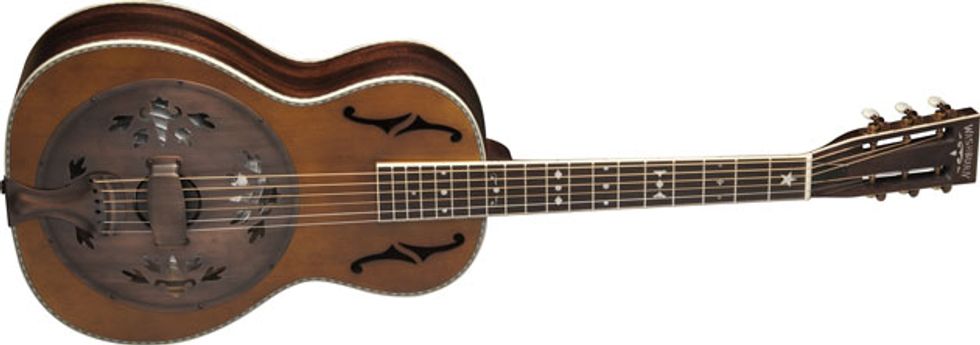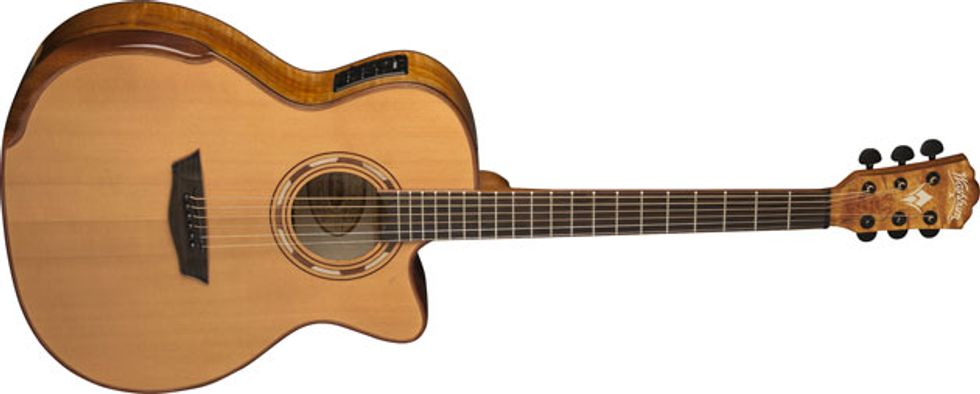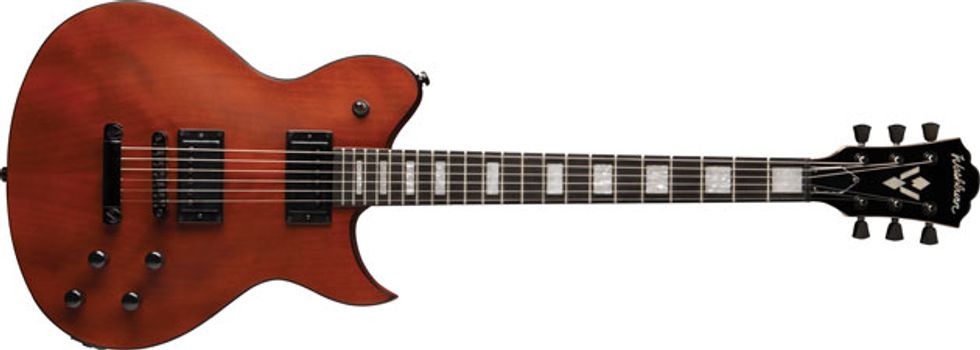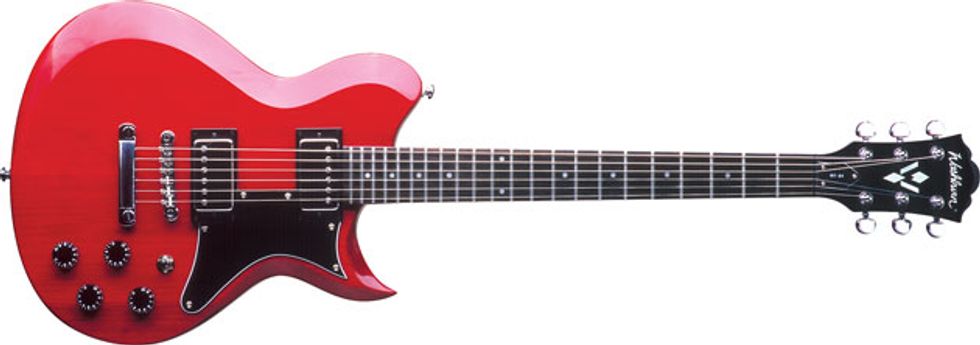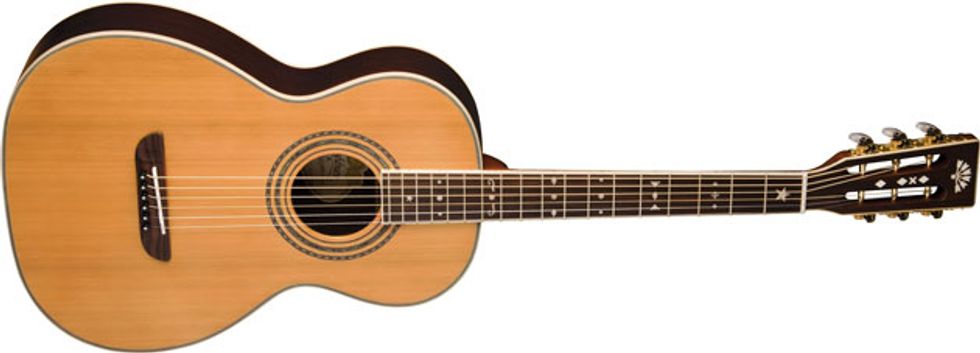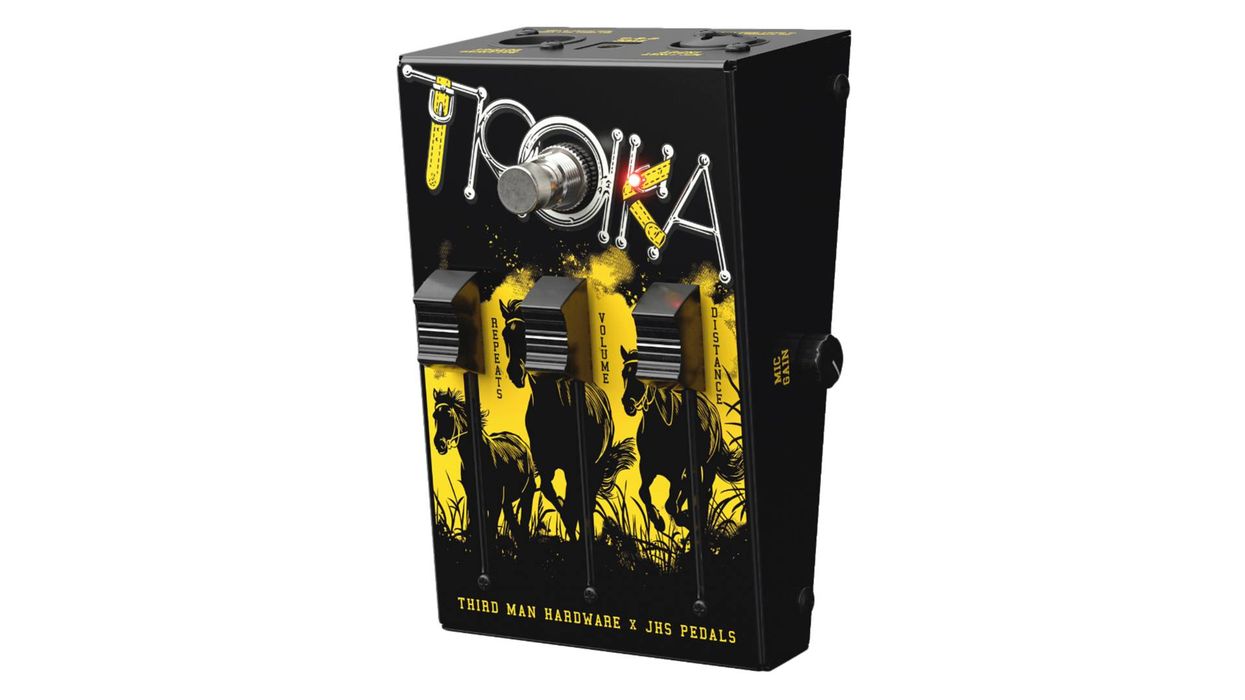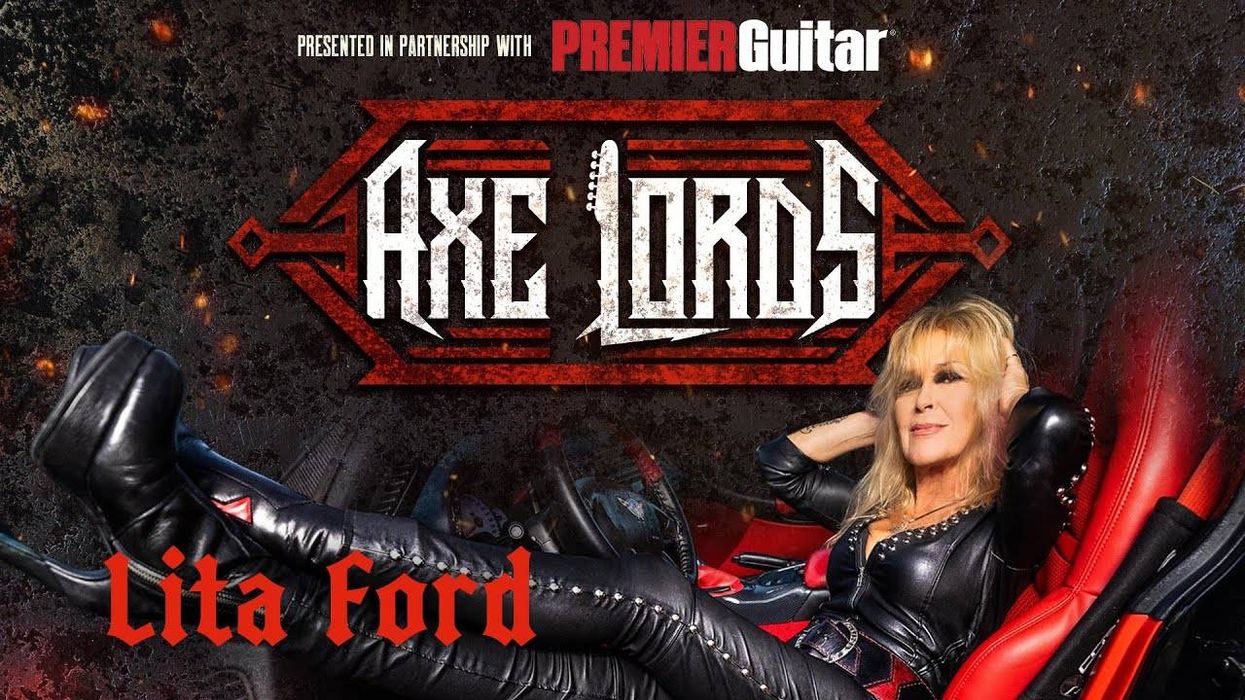Buffalo Grove, IL (January 22, 2014) -- The Nuno Bettencourt N4 has long been a popular model in the Washburn line. The combination of the Stephens Extended Cutaway with a Floyd Rose has proved irresistible to shredders the world over. Now Washburn ups the ante with the addition of a carbon fiber fretboard and stainless steel frets.
The N4CV’s 22 stainless steel frets are silky smooth and will last the life of the owner without needing replacement. The carbon fiber fretboard is extremely fast and slippery so bends and dives never bind your fingers.
The N4CV is made in the Washburn USA Custom Shop and features a vintage matte finished alder body with a Seymour Duncan '59 neck pickup and Bill Lawrence L-500 bridge pick-up complemented by a Floyd Rose bridge & locking nut system and Grover Exclusive 18:1 tuners. One of the hallmarks of the N4 is the Stephens Extended Cutaway on the maple neck which allows for unprecedented upper fret access. The Buzz Feiten Tuning System allows for perfect musical intonation at every point on the neck. The stripped down control layout features a 3 way pickup selector and 1 volume control.
The N4CV comes with a Washburn GCN4 hardshell case and retails for $3,999.90
Washburn Guitars announces the addition of 3 new parlor sized guitars to its broad line of acoustic guitars. The new parlors are based on designs Washburn used over 100 years ago.
All 3 parlor guitars are 24.75” scale and feature a natural stain finish, solid cedar top supported by quarter sawn scalloped sitka spruce bracing, abalone rosette and standard Washburn rosewood bridge. The mahogany neck features a rosewood fingerboard with 44mm nut and gold open gear tuners. These specs produce a nicely balanced tone perfect for fingerpicking and singer/song writers. The clarity of the parlor sized body is especially suited to recording and mic’d performance.
The WP26SNS features beautiful rosewood back and sides with highly stylized pearl fingerboard inlays and retails for $712.90.
The WP21SNS specs are identical to the WP26SNS with the exception of pearl dot inlays on the fingerboard. It retails for $622.90
The WP11SNS features mahogany back and sides for a slightly more focused, articulate tone and has pearl dot fingerboard inlays and retails for $533.90.
Washburn Guitars is pleased announce a new addition to its Idol family of solid body guitars, the WI40NM. The Idol series has been a popular line in the Washburn family for over 15 years and the new model builds on the Idol’s solid feature set and sexy looks.
The WI40NM features a solid 2 piece mahogany satin finished body with a Canadian maple set neck with recessed heel for upper fret access. The 22 fret ebony fingerboard accentuates the pearloid block inlays and the gloss black capped headstock features pearloid Washburn logo and stylized W inlay. The all black hardware compliments the mahogany and maple and features a tune-o-matic bridge with stop tailpiece and Grover 18:1 tuners with keystone buttons. The electronics are what make this guitar a real star. A hot alnico bridge humbucking pickup wound to 16k has been chosen to excel at rock tones and soloing. The neck alnico humbucker is wound to 8k for pristine jazz or rhythm tones. Both are controlled by separate volume and tone knobs. Taken together, this pickup combination makes for an incredibly versatile instrument.
The WI40NM comes equipped with D’Addario EX-120 strings and retails for $1069.90.
Washburn Guitars is proud to announce a new signature series with legendary Six Feet Under and Feared guitarist, Ola Englund. The new Solar Series is part of Washburn’s recently introduced Parallaxe Series. It consists of 6 and 7 string, 25.5” scale guitars offering standard Parallaxe features for the most demanding metal players with the addition of Evertune or Hipshot/style bridges. The Parallaxe Solar Series will feature 9 models, 5 of which will be built in Washburn’s USA Custom Shop just outside of Chicago and will cover a wide range of price points.
Parallaxe is Washburn’s recently introduced metal guitar series focusing on the worldwide rock/metal market and aiming to serve it with dedicated and advanced guitar technology. The line includes features that the most demanding rock/metal players have requested for years. It is stage & studio ready and packed with unique features such as the Stephen’s Extended Cutaway, Buzz Feiten Tuning System, Spring Silencers, big brass trem blocks, super jumbo frets, EverTune bridge and USA hardware & electronics.
Ola Englund is widely known for being the guitarist for legendary bands such as Six Feet Under, Feared and recently joined Swedish melodic death metal band The Haunted. He is also highly respected by the worldwide metal community for his professional YouTube demos and reviews for countless manufacturers.
Due to the success of last year’s USA Custom Shop P4 Princess, Washburn is adding another, more affordable model, the P2 Princess.
Like the P4, the P2 features a single cutaway solid mahogany bound body and is an exceptional value with premium hardware and electronics. It features USA Seymour Duncan pickups, Tune-o-matic bridge with Schaller fine tuning tail piece and Grover 18:1 chrome tuners, the combination of which provides unparalleled tuning accuracy and stability. The set mahogany neck features a 22 fret ebony fingerboard with tear drop inlays. The pickups are controlled by single volume and single tone knobs and selected with a 3 way toggle and the body shape is complimented by a 3 ply white/black/white pick guard.
The P2 is ideal for producing thick, meaty tones perfect for classic rock, blues and jazz. It is available in Black Sparkle and Silver Sparkle, comes equipped with D’Addario™ strings and includes a premium Washburn gig bag. The P2 retails for $1065.33
Washburn Guitars is pleased to add a new and unique parlor sized resonator to its line of resonator guitars, the R360K. With the current popularity of Folk and Americana music styles, the R360K brings a unique voice to the genre, thanks to its smaller body. Players looking to add new colors to their tonal palate via slide or fingerstyle will find the R360K to be the ideal instrument.
The R360K is a parlor guitar with a biscuit resonator cone. It has the look and feel of a guitar that would have been made in the early 20th century and played well since. It features a spruce top and Trembesi back and sides with a mahogany neck. The old style slotted headstock features distressed classical style tuners and classy pearl inlaid Washburn logo and design. The rosewood fingerboard showcases period correct traditional pearl inlays and has a 48mm nut width to facilitate fingerpick or slide styles. A custom cover plate with antique bronze finish matches the tailpiece and tuner hardware. Mirror image f holes adorn both sides of the fingerboard extension.
The R360K is equipped with D’Addario strings and includes a Washburn hardshell case. It retails for $1,069.90.
Washburn is pleased to announce the arrival of three new Idol models at this year’s NAMM in Anaheim, CA.
The flagship Idol, the USA Custom Shop WI68XVCG, makes its triumphant return in the stylish Cognac finish. It features a mahogany body with flame maple cap showcasing a reveal binding that lets the beauty of the flame show through. The mahogany neck sports a 22 fret rosewood fingerboard containing beautiful offset figured maple block inlays. Accented with classic gold hardware that includes Grover® 18:1 Rotomatic tuners, Tone Pros Tune-o-matic bridge and stop tailpiece and gold knobs. Gold covered coil tapped Seymour Duncan SH1N neck and SH11 bridge pickups complete this tonally versatile package.
The WI68XVCG is equipped with D’Addario strings and comes with a Washburn GC5 hardshell case. It retails for $3,999.90.
Continuing with our vintage finish inspired guitars comes the WI60V Idol. It features a solid mahogany spruce veneer capped body and a mahogany set neck with recessed heel for upper fret access. The 22 fret rosewood fingerboard accentuates the pearloid block inlays and the matte black capped headstock features pearloid Washburn logo and stylized inlay. The vintaged hardware compliments the finish and features a tune-o-matic bridge with stop tailpiece and Grover® 18:1 tuners with ebonite buttons to tie in with the ebony control knobs. Dual humbuckers give the guitar a warm, creamy tone.
The WI60V comes equipped with D’Addario EX-120 strings and retails for $890.90.
Originally introduced 15 years ago, the WI64 was the very first Idol model. The 2014 model WI64TRK reproduces every detail of the original right down to the revolutionary VCC tone controls. VCC varies the humbucker pickups from full humbucking mode to coil tapped mode and every tonal color in between. Go from thick crunchy tones to near single coil pristine tones by just rotating the knob. The WI64 features a thin mahogany body with set mahogany neck. The 22 fret rosewood fingerboard has dot inlays and the headstock features a gloss black cap with pearl Washburn logo and stylized W inlay. Hardware includes smooth operating chrome Grover 18:1 tuners, tune-o-matic bridge and stop tailpiece.
The WI64TRK comes in Trans Red, is equipped with D’Addario strings and includes a Washburn GB4 gigbag. It retails for $890.90
Washburn Guitars introduces the WCG66SCE acoustic/electric guitar. The newest addition to the Comfort Series is highlighted by deluxe features and stunning visual appeal.
The WCG66SCE is a Grand Auditorium style acoustic/electric guitar with a venetian cutaway for superior upper fret access. A highlight of the Comfort Series is the beveled strip of mahogany at the lower bout which becomes part of the mahogany top binding. The guitar features a book matched solid Cedar top, spalted maple back and sides, mahogany/maple bound body and headstock. The satin finished mahogany neck has an ebony fingerboard devoid of inlays and in tandem with the mahogany bound ebony bridge adds an aura of understated elegance. A maple/mahogany/maple strip splits the book matched spalted maple back as well. The spalted maple capped headstock features a pearl inlaid Washburn logo and stylized W as well as Grover 18:1 tuners with ebonite buttons. The gorgeous rosette is made of alternating maple and mahogany.
The WCG66SCE is a fantastic sounding acoustic guitar in its own right but the addition of premium Fishman electronics makes for an outstanding stage performance guitar. The Fishman Presys+ is an integrated tuner/preamp system for versatile amplified tonal shaping.
The WCG66SCE is strung with D’Addario strings and is an amazing acoustic/electric guitar as well as an outstanding value. Suggested Retail Price is $1,247.90.
Washburn is proud to introduce the new Willie Kahaiali’I, “Willie K”, Signature Jumbo Acoustic Guitar model WJ55SCENS. Willie is known throughout Hawaii as a legendary vocalist/instrumentalist who excels at a plethora of instruments and styles from traditional Hawaiian music through Blues and Rock to Opera!
With a slightly wider than standard nut of 44mm, the WJ55SCENS is a 25.5” scale Jumbo Acoustic Guitar with a cutaway and Fishman Electronics. It features a solid spruce top with quarter sawn scalloped Sitka spruce bracing for strength without weight, Koa back and sides and maple neck. The beautiful abalone binding ties in nicely with the abalone rosette as does the rosewood fingerboard with the rosewood bridge. A satin finish brings out the beauty of the wood and adds to a smooth playing feel. A rosewood capped headstock showcases a pearl Washburn logo and stylized W inlay and features gold tuners with black ebonite buttons. Included is the Fishman Presys+ Tuner/Preamp system for superior live sound.
Says Uncle Willie, “This guitar was built for men with big hands and big fingers and you know what they say about men with big hands, they play better!”
Washburn is pleased to be associated with a musician of such high a caliber as Willie K who also chooses the Washburn HB36 for his electric performances.
The WJ55SCENS, with its player friendly wider nut, is the ideal performance acoustic guitar. The WJ55SCENS retails for $1,158.90
Long a staple in Jazz, Blues, and Rock circles, and loved for its fat, meaty tones, the hollowbody has been ubiquitous in 20th and 21st century music. Washburn has contributed to much of that music and is proud to introduce the HB45WH double cutaway hollowbody guitar which is based on our best-selling HB35 model.
The HB45WH features a double cutaway maple body and includes a solid maple block in the center, increasing sustain and reducing susceptibility to feedback in high volume situations. Additionally, we’ve removed the F holes traditionally found on guitars of this style to further reduce susceptibility to feedback and contributing to an overall cleaner look. It features a maple neck capped with a 22 fret rosewood fingerboard with split block inlays. The gold hardware includes a tune-o-matic bridge and stop tailpiece with Grover® 18:1 Rotomatic tuners for exceptionally smooth tuning and stability. Humbuckers in the neck and bridge are selected by a three-way switch and provides players with a wide range of tones.
The HB45WH comes in Gloss White and is equipped with D’Addario™ strings and a Washburn hardshell case and retails for $1,247.90.
For more information:
Washburn
